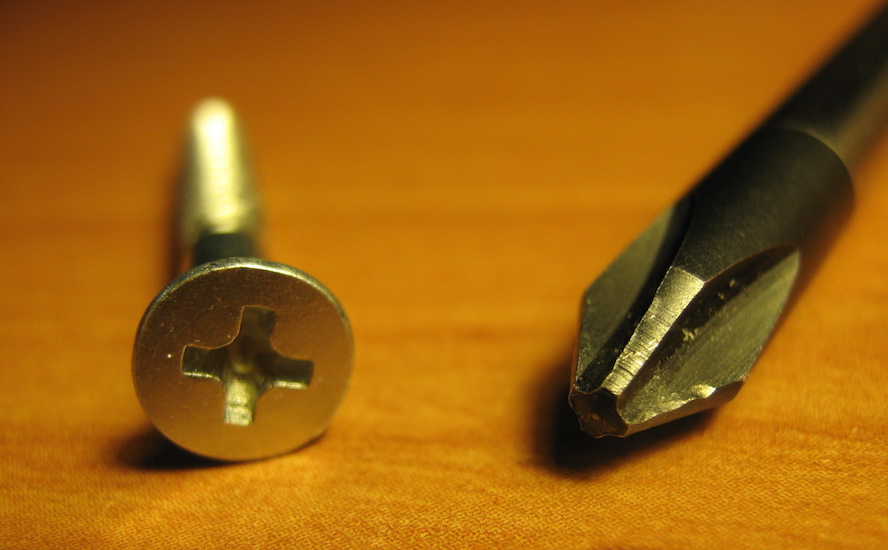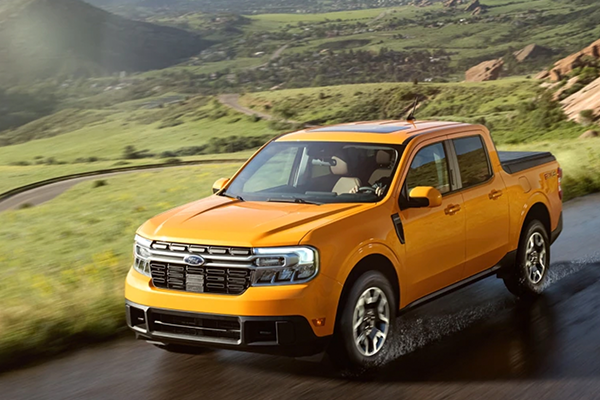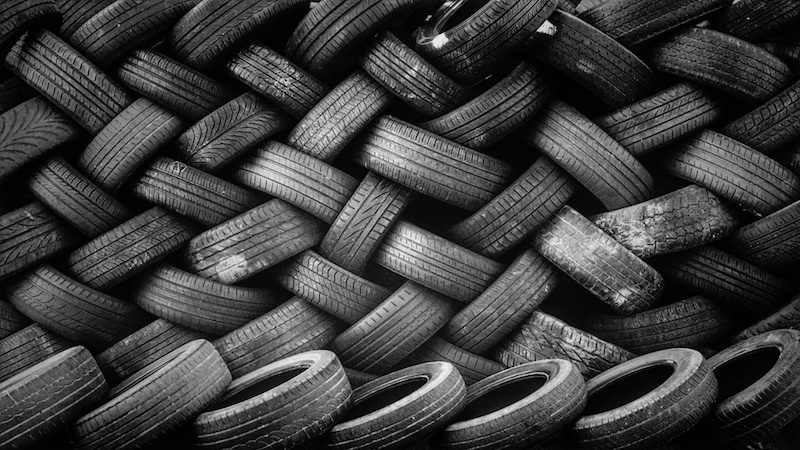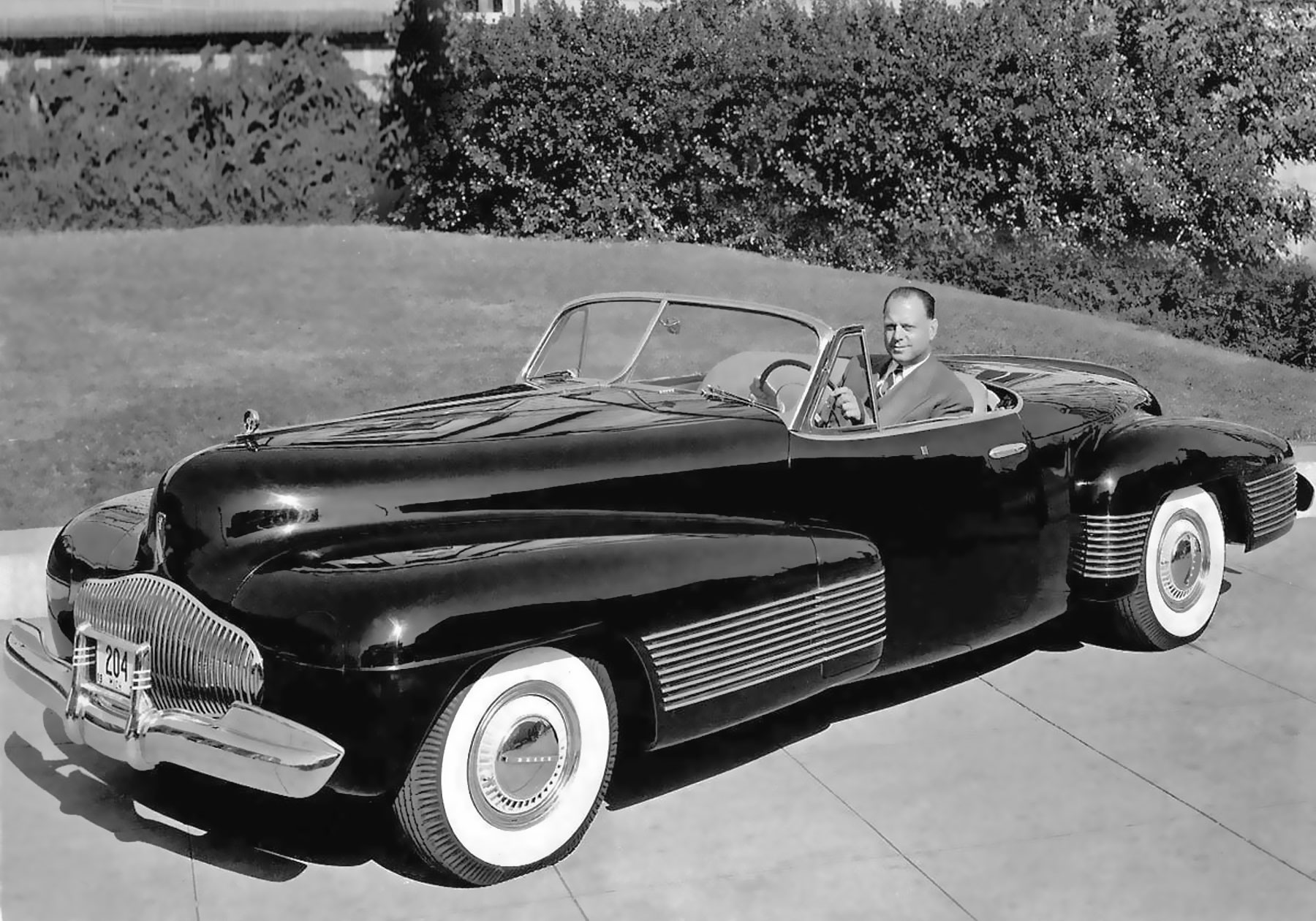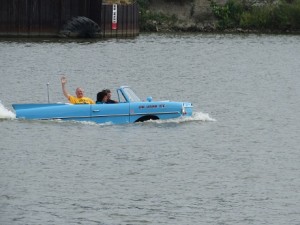 Herb de la Porte and his 1962 Amphicar 770. Photo credit: Tracy Isenberg.
Herb de la Porte and his 1962 Amphicar 770. Photo credit: Tracy Isenberg.
In honor of Go for a Ride Day, held annually on November 22, Advance Auto Parts presents “Braking for Fish.” To preserve our sanity and good health, we researched this story while it was still warm outside.
“For some reason,” Herb de la Porte from Elyria, Ohio wrote in a July 2013 YouTube description, “not too many folks ventured out on Lake St. Marys Saturday.” If you click on this 16-second video link, you’ll quickly see why. “Needless to say,” the description continues, “the roof was up and so were the windows. We still got soaked and the bilge pumps worked pretty hard.”
This video was shot from inside of Herb’s 1962 Amphicar 770, an amphibious vehicle built in Berlin, Germany. The Amphicar Corporation was originally funded by the German government and had ties with other German car manufacturers such as Borgward, Mercedes and BMW. The initial plan was to create 20,000 cars annually and targeted the North American market. The model number of “770” indicates that the vehicle can move 7 miles per hour in water and 70 miles per hour on land.
Herb bought his used Amphicar five years ago, with a price “in the mid-20s,” and he takes it out about half a dozen times a year, driving it for a couple of days each time; he then needs to remove the wheels and clean the brakes.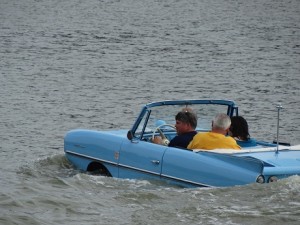 Photo credit: Tracy Isenberg.
Photo credit: Tracy Isenberg.
Nuts and bolts
The Amphicar 770 is a compact convertible with the following:
- 43 horsepower
- 4 cylinder engine in the rear; 1.2 liter Triumph Herald motor
- Custom 4-speed Hermes transmission, with the transmission driving the rear wheels through its one-of-a-kind land/water gearbox
- Braking and suspension systems that were sourced from Mercedes
- A Porsche transaxle
- 12-volt Lucas battery
- The highest rear fins of any car, about an inch higher than a 1959 Cadillac
- Steel body; the steel is thicker than on a typical car, with continuous welds
- Rubber strips in the doors that seal them as tightly as refrigerator doors
- Front wheels that serve as rudders/steer in the water
- Marine lights
- Bilge pumps
- A second gear that controls the two 12-inch propellers, both forward and back
To drive an Amphicar 770, an owner must get two licenses: one for land and the other for water.
History of amphibious vehicles
The advent of World War II provided the impetus for “making cars that can swim,” according to Popular Mechanics. Here are two examples:
- VW Schwimmwagen: this vehicle was crafted by the inventor of the VW Beetle, Ferdinand Porsche, for the German army. He’d made a larger version in 1941 and then scaled the vehicle down to create the VW Schwimmwagen. The vehicle was powered, according to the magazine, “by a 1.2-liter air-cooled flat four, which also drove a single propeller.” Front wheels served as rudders in water and, on land, the propeller swung up and disengaged from the engine.
- U.S. Army DUKW: Built by GM and nicknamed “Duck,” the United States military created this vehicle in 1942 to carry 5,000 pounds or 25 soldiers, with the ability to go 50 mph on land and 5 in water. George Patton used 1,000 of these vehicles when he landed in Sicily; 2,000 were used in the D-Day landing in France in 1944.
Then, Amphicars were manufactured in Germany from 1961-1967, the only mass produced non-military amphibious vehicle to date; somewhere between 3,700 to 4,500 of these beauties were built (estimates vary by source), with the great majority of them sent to North America (between 3,000-3,700 vehicles). The company invested $5 million in creating these watertight vehicles; the cost to purchase one was $2,900, at a time when a new Corvette cost just $3,400.
By 1968, new Environmental Protection Agency (EPA) and Department of Transportation (DOT) regulations made the manufacturing of an Amphicar too expensive, so the company stopped producing them. With today’s regulatory environment, it’s hard to imagine another mass produced amphibious car entering the market (but, never say never?).
It is believed that approximately 500 of the Amphicar 770 are still operational; 7 have been identified in the United Kingdom and 80 throughout the rest of Europe, so most are likely to still be in North America.
As a lighter note (we think!), rumor has it that U.S. President Lyndon B. Johnson used to enjoy scaring visitors by driving his Amphicar into a lake while pretending that his brakes had given out.
We need to go for a ride!
By now, some of us at Advance Auto Parts were curious enough about amphibious vehicles to ask for a ride in Herb’s Amphicar–and he graciously agreed, warning us that the vehicle “rides like a boat on land and like a car in the water.”
Meeting him at the Black River Wharf in the Cleveland area (Lorain, Ohio), we were amazed by the number of people who pulled out their cameras to take a picture as the vehicle made its way to the Black River, which is a tributary of Lake Erie. At the river’s edge, we were greeted by Rudy, the guard dog/adorable basset hound who lives in the bait shop–plus Gus, the friendly neighborhood goose. We were told that Rudy and Gus always get along–that is, until Gus steals some dog food, and then the fur and feathers fly. Rudy and Gus hard at work. Photo credit: Tracy Isenberg.
Rudy and Gus hard at work. Photo credit: Tracy Isenberg.
After being welcomed by people and creatures alike, Herb drove the Amphicar down a ramp and into the river. Although we got splashed when the vehicle initially hit the water, we otherwise stayed dry, thanks to better weather than when Herb visited Grand Lake St. Marys. All in all, the time in the water felt like an amusement park water ride, bumpy but not scary.
Don’t try this at home
When asked about his craziest Amphicar ride to date, Herb immediately knew which story to share. It started out as a relaxing water ride with his wife, Sheila. But. When Herb decided to head up to land via a sand bar, Sheila had this to say: “Herb, this sounds like a really bad idea.”
“No it isn’t, dear,” Herb responded. “You just need to trust me.”
The conversation continued along in that vein, with Sheila worried and Herb certain that they’d be just fine–until, that is, they got stuck. “Easy fix,” Herb reassured Sheila as he put the car in reverse, intending to get back into the water. But, he forgot to put his propellers in reverse and all he really got was even more stuck. The next time he tried to move the vehicle, the shaft got entangled in the sand and the propeller fell off. So, he got was stuck even further, half in the water and half in the mucky, yucky sand. Soon, they began to sink, until water nearly reached the vehicle’s windows. Two amphibious vehicles make their way across the English Channel. Photo credit: Ben Plewes.
Two amphibious vehicles make their way across the English Channel. Photo credit: Ben Plewes.
Seeing a need to revise his plan, Herb got out of the car and intended to call for help, until his wife realized that their cell phone was gone, probably lost in the lake. “By this time,” Herb says, “it was dark and desolate, and we were dripping wet. So we started walking, looking for a place where people might let us use their phone. Along the way, my wife kept repeating her original objections to my idea about driving up the sand bar, but in words that I won’t use right now.”
When the couple finally reached a well-lit building, it wasn’t the type of establishment to visit with a lady, but it had a phone, so they went inside. And, the first call Herb made from the bar’s phone was for coworkers to come get his wife. After that, he and a friend returned to the beach and tried to dig his car out of the sludge, but they failed.
Giving up for the night, Herb returned the next morning with a group of volunteers, and one of them noticed a backhoe being used to redo a nearby lawn. Renting the backhoe from the homeowners, they dug a path from the lake’s edge to the nearest road and the people living in the area helped Herb to get his car to dry land, using four wheelers as needed. “After that,” Herb says with a sigh, “my wife has been more pensive and less trusting of me whenever we get in the Amphicar. Go figure.”
On the other side of the pond
The love of amphibious vehicles is felt and shown in many places around the globe. In fact, Englishman Doug Hilton has created a website, Land, Air and Sea, to showcase his proposed museum that will be specifically dedicated to dual-purpose vehicles, including but not limited to the Amphicar.
He describes the vision of his future museum as follows: “This is a collection of mechanical ambition, enthusiasm and aspiration and about the importance of having a go, not just about preserving history. We aim to show that individuals can dare to follow their dreams, to be different, to reach out and create things and then to pass on the torch of inspiration to others. If things do not perform as well in the end as one hoped, then have another go or use the knowledge gained elsewhere. As Taylor, the inventor of the Aerocar of the 1950s is reported to have said, ‘if it weren't for us nuts, you'd still be reading by candlelight and wearing button shoes.’”
Just a few of the items collected by Doug for eventual exhibition include a fold away float plane, amphibious bicycles, “one of the amazing Rokon go anywhere off road motorcycles from the US” and a swamp crawler. The latter was created when an agricultural machine dealer put together the following pieces and parts, among others:
- Old Land Rover wheels mounted on steel rods
- Tracks from an old excavator
- Sprocket drives to add to the end of the excavator
- Hydraulic parts from an old air compressor
- 60 year old Morris Minor car engine
This vehicle worked well, both on land and in swamps, but then sat in a barn for 10 years before Doug rescued it for his museum.
When asked how his plan for a museum is progressing, the good news is that he has “one of everything I need now for the museum that can be reasonably stored in shipping containers and barns around the country, and many more items that people want to loan if we need them.” What’s still missing, then? “Premises, time and cash are the only missing ingredients,” Doug says. “Still bags of enthusiasm, though, and lots of exciting projects and interesting people always buzzing around.”
He notes that many of his exhibits have come from the United States, rather than from his country of England or elsewhere in Europe. Why? He believes it’s because the US allows “backyard mechanics” to have the “mental freedom of improvisation and creation.”
Doug enjoys writing about what he discovers, particularly looking for stories about “the human endeavor in the making of a machine, because this puts creative invention across to people as a living story . . . and most of these simple, crazy and fun looking machines cover some very complicated technical, mechanical, lifestyle and endeavor issues.”
Another example of “don’t try this at home”
On November 6, 2006, Doug and Adam Solomon climbed into an amphibious car built in the United Kingdom, the Dutton. Next to them, Tim Dutton, creator of the Dutton, climbed into another of his amphibious cars. Their goal was to cross the English Channel in these vehicles, starting in England and ending up in France. This had never been accomplished in civilian amphibious vehicles and the purpose of the crossing was to draw attention to a wildlife cause (involving geese) that is close to Doug’s heart. He therefore had Percy, a plastic goose, attached to his vehicle so Percy could “fly” alongside him on his adventure.
To call this an ambitious undertaking is an understatement. The narrowest portion of the English Channel is approximately 20 miles wide; this area is known as the Strait of Dover in England and as the Pas de Calais in France. The depth of this waterway ranges from 120 to 180 feet, with strong winds a constant possibility. Doug Hilton and Tim Dutton stand by one of the amphibious vehicles used to cross the English Channel. Photo credit: Ben Plewes.
Doug Hilton and Tim Dutton stand by one of the amphibious vehicles used to cross the English Channel. Photo credit: Ben Plewes.
To avoid the worst of the weather-related challenges, the men chose a calm time in August to attempt the crossing. As luck would have it, though, “last minute intermittent electrical problems” took place–and then the weather turned bad, causing a lengthy delay. Waves were choppy and the wind was going against tide, a combination that contributes to making the English Channel one of the most unpredictable sea places on the planet.
For three long months, the men “sat glued to the daily forecasts” until, finally, a 24-hour “weather eye appeared.” It was now wintry, with fewer hours of daylight to assist in this endeavor. And, just when Doug, Adam and Tim thought all was a go, the men struggled with getting appropriate permissions; for liability reasons, they ultimately needed to sign a £5 million GBP indemnity and listen to a health and safety presentation before launching.
Finally at 10 a.m. on November 6, the quest was on! “Both cars,” wrote Doug, “slid gracefully into the water from the narrow slipway and the raucous clatter of the engine rose.” Once they began to travel, though, they quickly discovered why officials had been so dubious about their plan. The men found themselves surrounded by turbulent waves, “with the cars rearing, rolling and pitching, regularly disappearing from each other’s view.” A new wave hit them every few seconds and all they could do was hang on, especially since their water-soaked CB radio had already hissed and died, and their glasses were horribly smeared by salt water.
These conditions lasted for the first two miles of their journey before the weather somewhat calmed down. Here is more detail: “wave chop had finally reduced to about 60cm, with regular swells of twice this but it felt like a cruise compared to what had gone before.” Another crisis occurred when the emergency tow rope in Tim’s car was torn loose by the waves and had wrapped itself around his front wheel. They needed to prevent the rope from going through the propeller, so they stopped and spent 15 chilly, nerve-wracking minutes on this repair.
When the men finally reached Calais in France, it was pitch dark–and seven long hours and nine long minutes after they’d left England’s dry shore. Two loyal friends were waiting on the shore to cheer them on as the men climbed up on land; soon afterwards, a small crowd of people came by to see what the heck was going on–which was the first successful crossing of the English Channel by amphibious vehicles.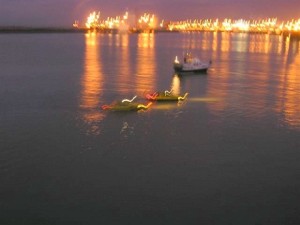 Entering the Calais Harbor in France. Photo credit: Ben Plewes.
Entering the Calais Harbor in France. Photo credit: Ben Plewes.
Whenever someone asks Doug if he intends to repeat this experience, he says that, “Once was enough.” He says that plenty of people have offered to pay him money to take them across the English Channel in an amphibious vehicle, “but, to me, there is no point. I already did it.”
Now that he can look at his trip in hindsight, he tells Advance Auto Parts the following: “Like so many things, it was a challenge at the time. But, when these types of things are done, it feels almost as if it was someone else that did it, and only memories and photos remain.”
He admits that numerous people tried to talk him out of this trip, including his wife, “who really thought all was lost, but I didn’t see it that way, then or now.”
The appeal of the amphibious
Clearly, the pull of the amphibious is strong for people like Herb and Doug. Wanting to know why, we asked the question; and we found out that driving or riding in an amphibious vehicle is, according to Doug, “a really weird experience, and the transition between water and road–and road and water–never fails to bring a smile onto my face even when the sky is grey.” After you ride in one, he shares, “you are left with a nagging feeling that something highly unusual happened . . . it can make you an addict as you come back, time and time again, to try to capture exactly what that mystical thing is.”
“That’s the mystery of all multi-role machines,” he muses. “They are built by people who haven’t learned yet that it’s impossible to build what they are intending to do–and, as a result, they have just gone ahead and done it.”
“I can only akin it to something like a sense and feeling of freedom, empowerment, joy and excitement in a blow being struck for mankind against the impossible when they see that someone has dared to be different and has pulled it off.”
Editor's note: What’s the most unusual way you’ve ever gone for a ride? Let us know in the comments below!
